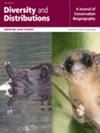Human-Driven Extinctions Rapidly Alter the Island Biodiversity Patterns of Large and Medium-Sized Mammals in the Largest Archipelago of China
Abstract
Aim
Islands are regarded as ideal ecosystems for exploring biodiversity patterns. However, numerous islands have also suffered large numbers of species extinctions due to human activities. The extent to which such species extinctions have influenced our ability to understand biodiversity patterns, particularly the factors regulating island biodiversity, is still unclear. The purpose of our study was to disentangle the effects of recent human-driven extinctions on island biodiversity patterns.
Location
Zhoushan Archipelago, China.
Taxon
Large and medium-sized mammals.
Methods
We conducted field surveys on 30 islands with available recent data on large and medium-sized mammals. We then calculated the alpha diversity and beta diversity from taxonomic, phylogenetic, and functional facets for natural (including both extinct and extant populations) and current assemblages (excluding extinct populations) on 24 islands that supported at least one extant mammal species. Finally, we assessed the changes in these diversity metrics and their key drivers between natural and current assemblages.
Results
Both alpha and beta diversity of taxonomic, phylogenetic, and functional facets have decreased in current assemblages compared to natural assemblages. Additionally, distance to the nearest mainland had significant effects on all alpha diversity metrics for natural assemblages, and island area significantly influenced all beta diversity metrics for natural assemblages, but these effects were not observed in current assemblages.
Main Conclusions
Our findings showed that fundamental diversity patterns at both alpha and beta levels have been rapidly altered by human-driven extinctions, highlighting humans as a major force in island ecosystems. We thus emphasise that assessing biodiversity patterns based on natural assemblages is important to improve our understanding of the evolutionary and ecological determinants of island biodiversity as well as to provide a benchmark for biodiversity conservation.


 求助内容:
求助内容: 应助结果提醒方式:
应助结果提醒方式:


